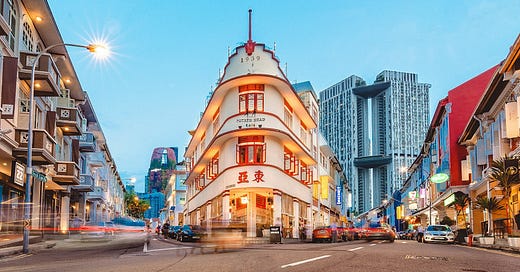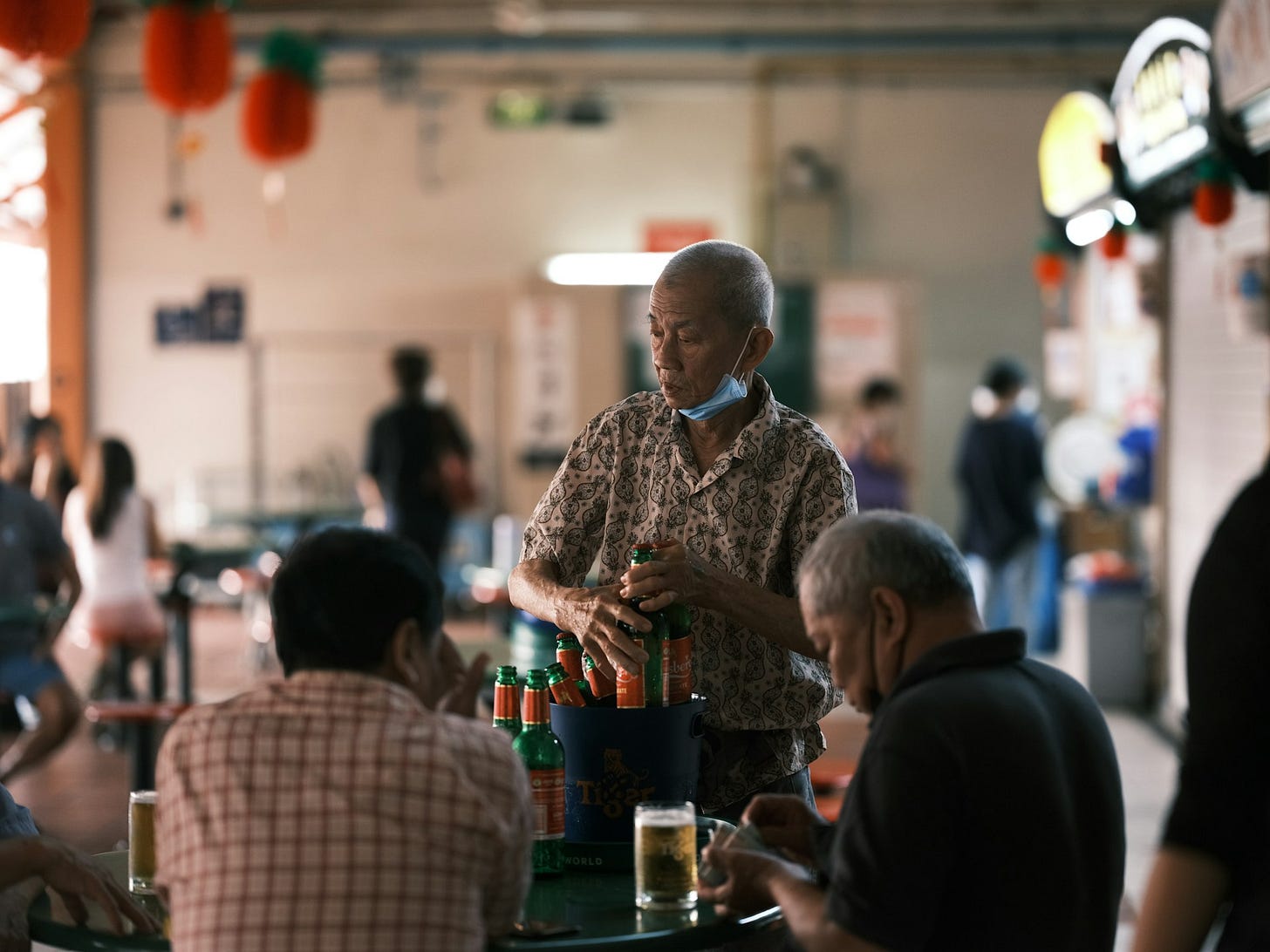Singapore dialogue on monopoly and regional stability
Three friends sit down for $150 of food—three beers, three cheese burgers, and three french fries. They’re on Keong Saik Road. It’s an old ShopHouse street in downtown Singapore. Towering above the street is THE PINNACLE AT DUXTON—a 50 story public housing arcology. The Shophouses originally functioned as warehouses during Singapore’s colonial days. Today the shophouses are home to modernist restaurants and cocktail bars with $50 drinks.
G: I’m sorry I took us here. The burgers are good, but they’re not worth $150.
R: This is a delicious but entirely obscene burger. It’s not even opulent.
G: Though it does really drive home the whole world I was trying to communicate before you came. Most of the restaurant-goers in this neighbourhood are using corporate expense accounts. There’s no price discovery in the market
S: It’s a bit like airline points: the airlines incentivize business people with small status perks, and convince them to fly based on brand loyalty rather than cost efficiency. All airline profits are made from business people spending company money with a dramatically lower discretionary threshold.
G: That’s exactly the case here—and the city bifurcates with the same dynamics as an airline cabin: business and economy , or an extreme high end dining scene, and a widespread hawker culture
R: Why did we need to choose the business class burger experience?
S: It’s important we experience it. I don’t think I would have believed it otherwise. In any case, it’s a wonder to be on this weird little island, with its weird little burger expense account dynamics. I’m feeling a certain jealous pang actually—I went back to Sri Lanka for the first time since COVID. I reckon it was on par economically with Singapore when my family emigrated in the early ‘90s. It’s a wonder to see how much Lee Kuan Yew’s vision took the nation forward in the intervening years.
R: Be careful with the state worship
S: No I’m serious though—a robust, multi-racial, internationally open city state
G: I think the official figure is something like 1,500% GDP increase for the average Singaporean since independence in the 1960s. S’s right—there’s an immense wonder here. Economic growth so rapid there’s a huge inter generational cultural problem here: grandparents raised on $100 a month parenting grand children with BMWs and 7 figure homes.
S: I just wonder what course Sri Lanka would have taken if they’d adopted an economic and political system like Singapore
G: It’s pretty remarkable—Southeast Asia is something like 650 million people and Singapore is only 5 million. It’s less than 1% of the regional population, but 95% of all IPOs in the region flow through here. And contrary to the international view that the city is hyper capitalist, there’s a robust social democracy underlying things: 80% of housing in Singapore is government subsidized. Singapore has one of the highest rates of home ownership in the world, and the ratio of the average income to the average unit of subsidized housing is one of the lowest of advanced countries in the world. Don’t get me started on where I live though. My rent increased by almost 50% this year. There’s no government control for foreigner condos.
R: I take your point about the social democracy—it does recall some of the postwar British system—but I don’t think that captures things. Social democracy often disguises or launders global extraction.
S: This isn’t some nordic nanny state.
G: Though it is somewhat extractive! The government courts high value industries like Big Tech, Pharma, Crypto, Finance and Oil and Gas and gives them a comfortable tax rate in exchange for patronage labor policies that keep the electorate happy. In my previous multinational our corporate tax rate for all Asia-Pacific revenue was inversely proportional to the number of folks we employed here.
S: The system sustains itself.
G: Yeah, and the resulting stability begets more prosperity. It’s a sort of negative feedback loop seeking the most investible environment for global capital. Legal stability, environmental stability, hell, even the sunrise and sunset don’t vary through the year—seven and seven. If I recall correctly the ratio of Chinese to Malay to Indian Singaporeans is almost the same now as it was at independence: 74%, 14%, 9%.
R: The most investible country is the most predictable country. Singapore stability has reached escape velocity, so it collects a system tax on all capital flowing through the region.
S: This doesn’t change the fact that the roads, the universities, the housing here are better than anywhere I’ve lived. And it gets back to Lee Kuan Yew. There’s a non-trivial set of governance decisions that got the country here today.
R: Sure, but the value being created here is regionally zero-sum—if Johor snapped its fingers and revealed comparable state institutions, infrastructure, it wouldn’t mean twice as much GPD across the Johor Strait, but half as much. Your alternative Colombo history glosses the fact that value is being captured instead of created.
S: Seems a bit reductive to me.
G: Let’s go to the hawker center.




